Faculty and Staff
Click here to add your own text
“We truly need to integrate agriculture into our urban systems to tackle food insecurity for the populations that are most underserved.” -Kathleen Chen
Kathleen, a second year graduate student, and Yi Shen, a first year graduate student, are tackling food insecurity for over 50 veterans through an ambitious renovation of the VA (Veterans Affairs) Garden. The duo, both studying chemistry, work through the INFEWS (Innovations at the Nexus of Food, Energy, and Water Systems) program to improve access to nutritious food, create jobs, build community, and aid in therapy for psychological issues veterans often face.
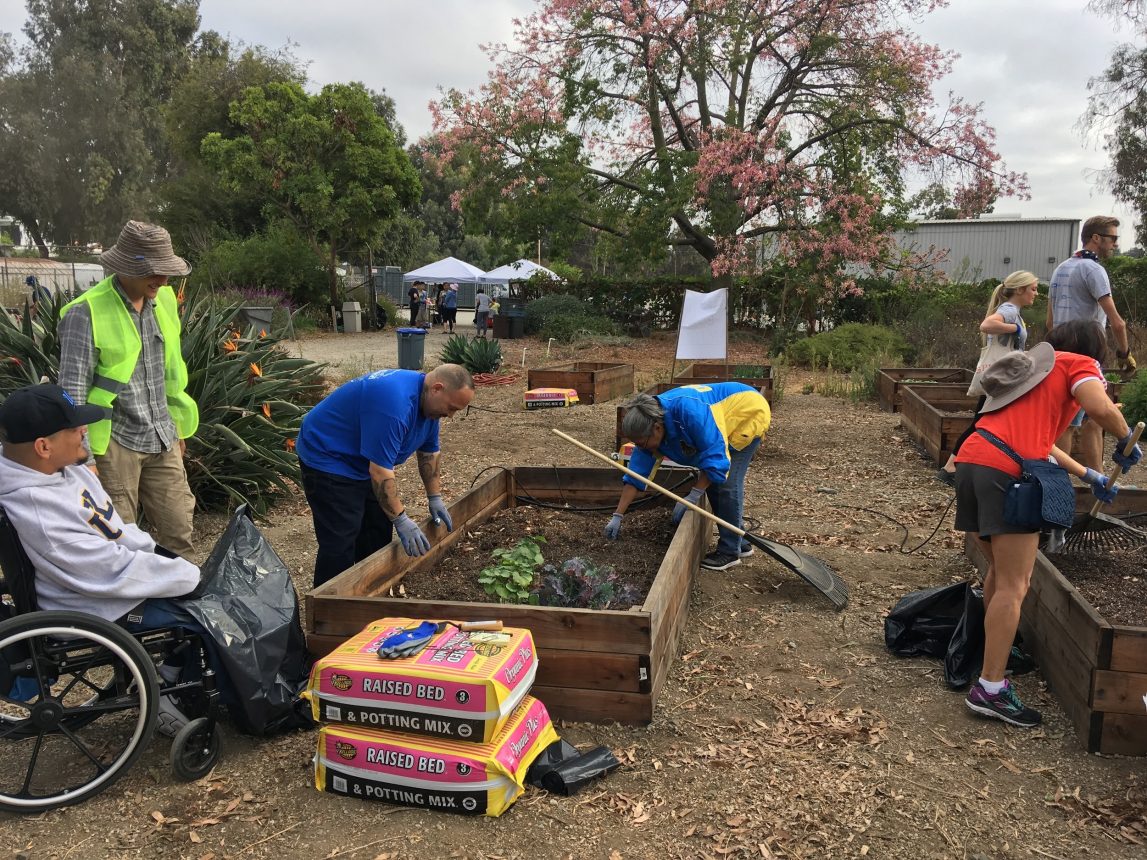
Veterans and Volunteers Planting at the VA Garden. Photo by Tammy Wong.
The USDA defines food insecurity as a state in which “consistent access to adequate food is limited by a lack of money and other resources at times during the year.” Two terms, low food security and very low food security break the definition down further. Low food security may result in reduced variety, quality, or desirability of diet, while very low food security, formerly known as food insecurity with hunger results in actual reduced food intake.
In America, 1 in 8 people report being in a state of food insecurity, and among veterans, the numbers are much higher. More than 1 in 4 veterans (27%) from Iraq and Afghanistan wars report problems with food security, where 15% of those surveyed reported low food security and 12% reported very low food security.

In 2016, UCLA committed a total of $16.5 million to a partnership with the Department of Veterans Affairs. This money was dedicated to, among other actions, the rejuvenation of the VA garden. This kickstarted the transformation of the area into a space for recreation, leisure, and therapy, as well as an easy way to provide nutritious food to veterans in the area. Yi and Kathleen’s project has been in the works since September 2018, and catalyzes the overall process through four objectives.
In order to achieve improved food security for veterans in the area, Kathleen and Yi outlined their goals as follows:
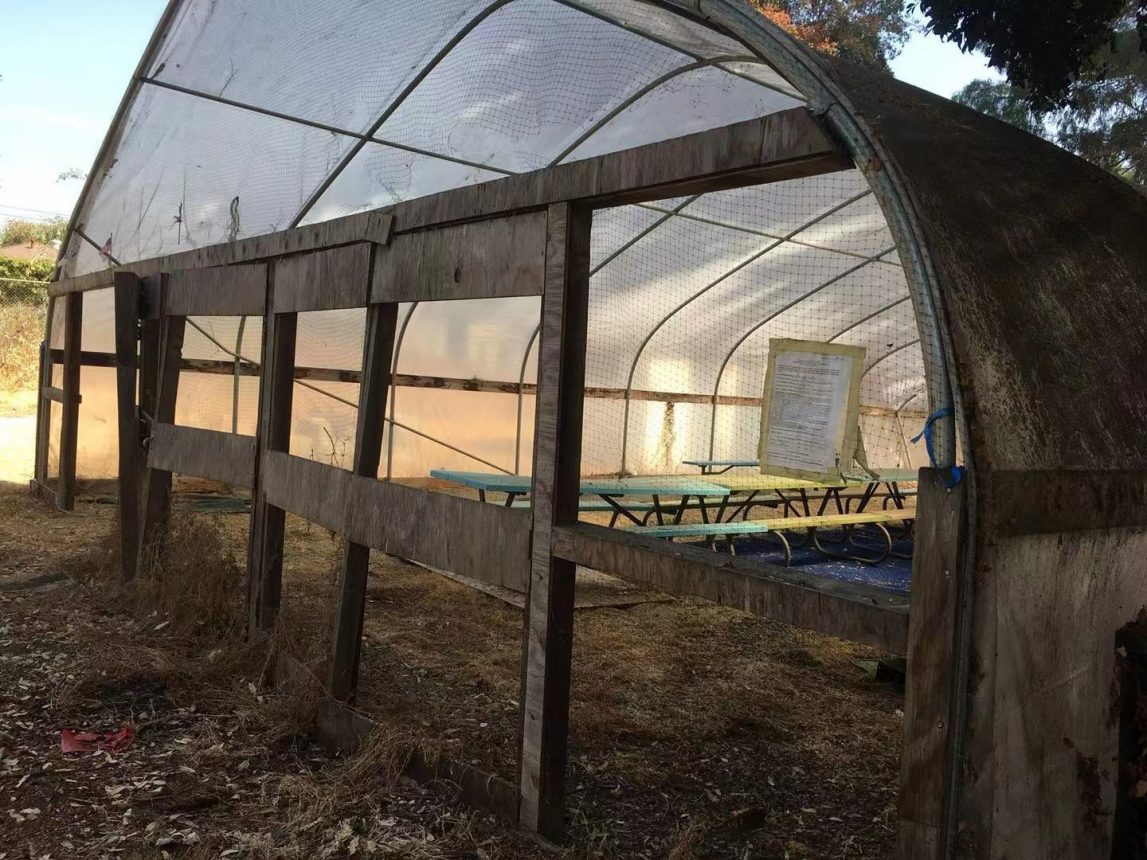
Classes on gardening, cooking, and nutrition can be held in outdoor rooms near the garden. Photo by Yi Shen.
So far, Aims 1, 2, and 4 are close to completion, but the project ends for Kathleen and Yi at the end of Fall Quarter, 2018. Though they will no longer be heading the initiative, Kathleen plans to continue volunteering at the garden, and continue with her research in “soil conditioners to improve water conservation in agriculture.” She feels that the project “was really beneficial for giving context to [her] own research and strengthening [her] motivations.”
The garden restoration continues only with maintained volunteer contribution. Feeding more than 50 veterans through small-scale agriculture is no simple task, but the success of the program thus far signifies a major step towards improving food security for the veteran community as a whole.
To get involved with Kathleen and Yi’s project, either as a volunteer or even a new project manager, email either of them directly at kkchen@ucla.edu or shenyi.1995@gmail.com. A volunteer sign-up form can also be found here.
Click here to learn more about the benefits of the VA garden on employment, social well-being, and psychological health.
Patience Olsen is an undergraduate student at UCLA majoring in Civil Engineering. In addition to blogging for the EatWell Pod, she volunteers at the Mildred E. Mathias Botanical Garden on campus, and is a member of the ASCE Environmental Design project.
Given we are now in December and looking forward to festivities the season brings regardless of religious or political beliefs, many of us can agree that ginger is a key spice of this time of year. The smell and taste of ginger create lingering memories. Whether found in gingerbread houses, ginger snaps, candies, or added to favorite beverages, most people enjoy this ancient spice.
Zingiber officinale is a rhizome from the Zingiberaceae family. When we think of ginger, most of us think of the Jamaican type, which is of the highest quality, which despite its name is cultivated in China, Japan, Indonesia, Australia, Sierra Leone, Nigeria, and the West Indies. So widely used in all cultures, I am pressed to name a cuisine that doesn’t include it.
This ancient spice has been documented in 3000 BC in the early Chinese writing of Shen Nung, the Father of Chinese medicine. He claimed the consumption of ginger “eliminates body order and puts a person in touch with the spiritual realm.” It is also found in the writing of Confucius as early as 500 BC. The name goes back to Sanskrit, sringavera, and was probably used in India as far back as 3,000 years ago. The original homeland of ginger is still uncertain as it no longer grows wild, but Southeast Asia is the most probable location. Lore has it that as early as 77AD Dioscorides, the Greco-Roman “surgeon general” of emperors Claudius and Nero, declared in his book De Materia Medica that ginger not only would warm and soften the stomach, but was also an excellent broad-spectrum antidote. Ginger made its way to Europe through the usual routes of the spice trade, one of them established by Marco Polo. It then made its way to the New World through European settlers.
Ginger is a mild stimulant that promotes circulation. It is used medicinally to aid digestion, decrease nausea, treat morning sickness, and enhance the immune system. It is also used as a topical skin treatment to reduce irritation and to soothe a sore throat from colds and influenzas. Now I must say, I am not a doctor nor do I play one on television, so I cannot confirm that all of the associated medical claims and benefits work or are effective. But what I do know is that ginger is delicious and can enhance the flavor of most recipes. Whether you are making a soup, roasting meats, grilling fish, spicing up a vegetable stir-fry, brewing a beverage, or whipping up your favorite dessert, you can’t go wrong with adding ginger.
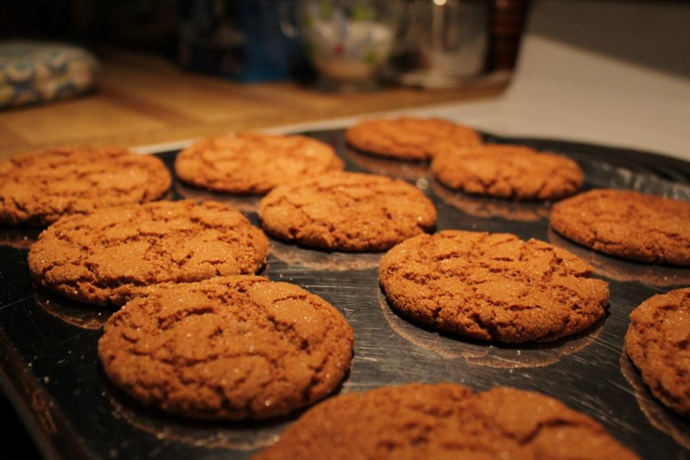
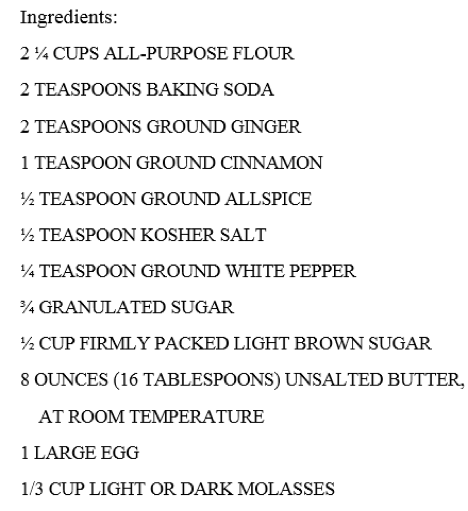
– MAKES ABOUT 60 COOKIES –
In a bowl, stir together the flour, baking soda, ginger, cinnamon, allspice, salt, and pepper. Set aside.
Combine ½ cup of the granulated sugar, the brown sugar, and the butter in the bowl of a stand mixer fitted with the paddle attachment and beat on medium speed until smooth, about 1 minute. Add the egg and beat until mixed, then beat in the molasses until blended. Reduce the speed to low, add the dry ingredients, and mix until incorporated. Refrigerate the dough for 30 minutes.
Preheat the oven to 325°F. Line 2 baking sheets with parchment paper.
Spread the remaining ¼ cup granulated sugar in a small, shallow bowl. To shape each cookie, using a small spoon or ice-cream scoop, scoop up a spoonful of the dough and roll between your palms into a ¾-inch ball. As the balls are formed, roll them in the sugar, coating evenly, and then place on the prepared baking sheets, spacing them 2 to 3 inches apart. Flatten the balls slightly with 2 fingers.
Bake until golden brown and set around the edges but still soft inside, about 12 minutes. At the midway point, switch the baking sheets between the racks and rotate them 180 degrees to ensure even baking. Let cool on the baking sheets to room temperature.
The dough may be made up to a week in advance and kept in the refrigerator. The cookies may be baked a day ahead. Store in an airtight container at room temperature.
(Recipe from Classic Stars Desserts; Favorite Recipes by Emily Luchetti)
Al Ferrone is the senior director of Food & Beverage at UCLA Housing & Hospitality Services. With extensive years of food and beverage/hotel experience, Al Ferrone manages all areas of F&B for UCLA including Dining Services, Lake Arrowhead Conference Center, the UCLA Meyer & Renee Luskin Conference Center, and UCLA Catering. Prior to UCLA as the Vice President of Food & Beverage, he played a significant role in the guidance of hotel and F&B strategies at Caesars Entertainment Corporation, Hilton, and Interstate Hotels Corporation. He has worked with a wide-ranging family of hotel and casino brands. He also developed and independently managed the Hilton Restaurant Group, which consisted of freestanding restaurants with over eight concepts.
Any person who eats at Bruin Plate for the first time is immediately aware that this is no regular college dining hall. The menu reads like one you might find at a 5-star restaurant, with dishes like “Rosemary, Gorgonzola, & Roasted Grape Flatbread”, and a variety of ingredients completely foreign to typical dining hall cuisine, from wheat berry, to jicama, to seitan. The aptly named residential restaurant sets itself apart from other college dining options and represents potentially the first dining hall in the country in which all menu items are made from scratch, with a focus on health, sustainability, and flavor.
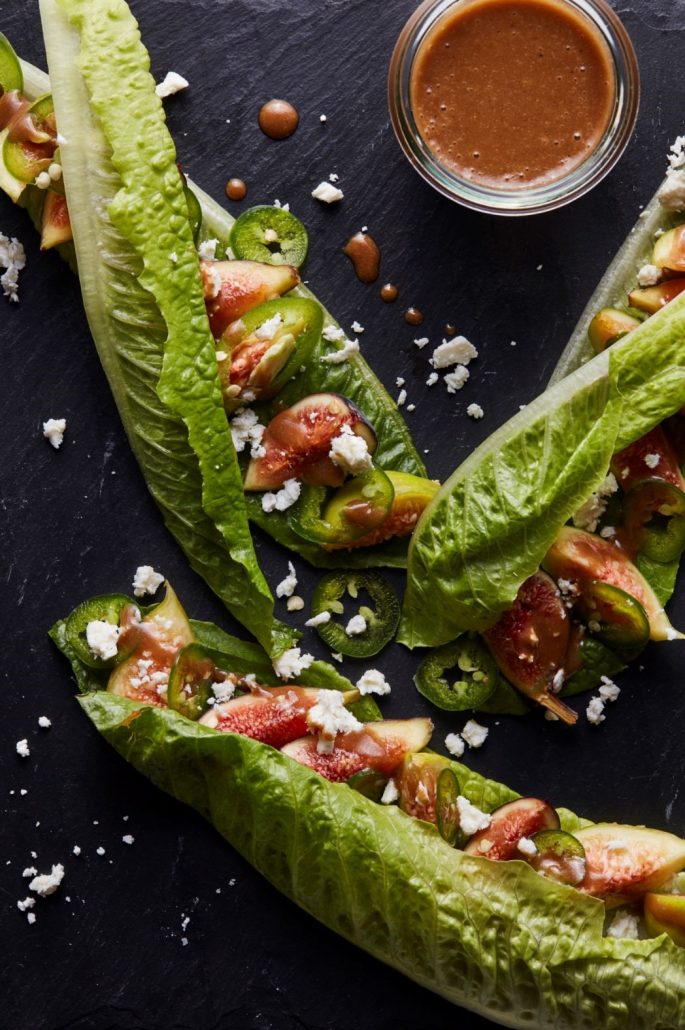
Fresh Fig, Feta, and Jalapeño Salad, page 19, Bruin Plate Cookbook
At just under five years old, Bruin Plate has already established itself as a distinguished dining hall, with awards including the FM Best Concept Award for Best Menu in 2012 and a four-star Certified Green Restaurant designation in 2017, making it the third dining hall in the nation to receive the highest award given by the Green Restaurant Association. It also boasts a rating of five stars on Yelp, and contributes to the rating of UCLA dining halls as best in the nation for the past two consecutive years.
Maddie Cashel, a sophomore, endorses the restaurant, “I love healthy options right at your fingertips. I love eating healthy food that’s not just salad, and [Bruin Plate] has so many vegetable options with protein that you don’t find at other dining halls.” Those who often choose Bruin Plate over other dining halls share this sentiment that healthy eating should be both easy and interesting– there exists more nutritious food than uninspired salads and flavorless steamed vegetables.
Students savor the taste of Bruin Plate for as long as they live on the Hill, but the difficulty lies in the fact that this usually lasts only a year or two. Students tend to move into apartments off-campus for their third or fourth years as undergraduate students, where they must either begin to cook for themselves, or rack up charges by ordering take-out for every meal. In both cases, these meals are often much less nutritious and less sustainable than their Bruin Plate counterparts. One student planning to live off the Hill next year laments, “What am I going to do without the salad bar and the chocolate peanut butter?” Other Bruin Plate fans, such as staff and faculty, may hear much about the award-winning cuisine but comprise a miniscule percentage of people who actually eat at the dining hall on a regular basis.
The Bruin Plate Cookbook, released only a few weeks ago, aims to solve these problems. Pete Angelis, Assistant Vice Chancellor of UCLA Housing & Hospitality Services, endorses the motive behind the cookbook, “the Bruin Plate cookbook is the culmination of Housing & Hospitality Services’ efforts to make the healthy choice, the easy choice, for our students, staff and faculty. We are pleased to be able to share these nutritious AND delicious recipes with others through the publication of the Bruin Plate recipes in the cookbook.”The message is clear: anyone who enjoys healthy, delicious cooking with a side of environmental stewardship can benefit from the cookbook.
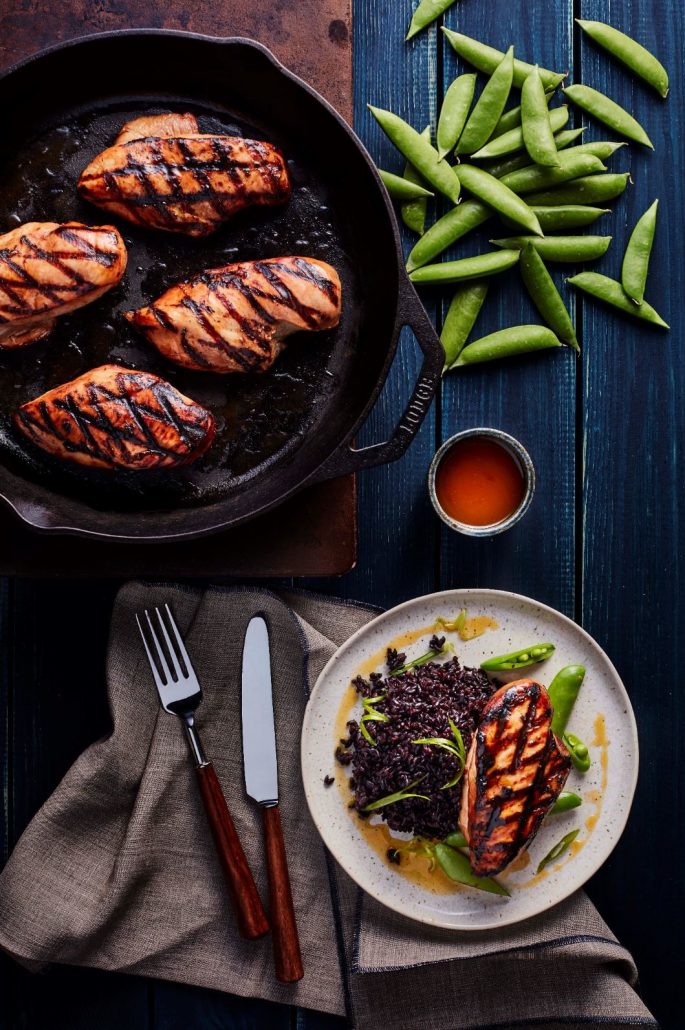
Aromatic Spiced Chicken with Snap Peas and Forbidden Rice, page 146
The cookbook highlights not only dishes actually served at Bruin Plate, but also dishes inspired by the residential restaurant that don’t often make it onto the menu, such as Fresh Fig, Feta, and Jalapeño Salad1 and Aromatic Spiced Chicken with Snap Peas and Forbidden Rice2. Each recipe was scaled down by Bruin Plate chefs, from portions to feed hundreds to portions to feed only one or two hungry mouths. Each recipe also includes nutritional information per serving.
Two sample recipes, taken directly from the cookbook, are pictured below.
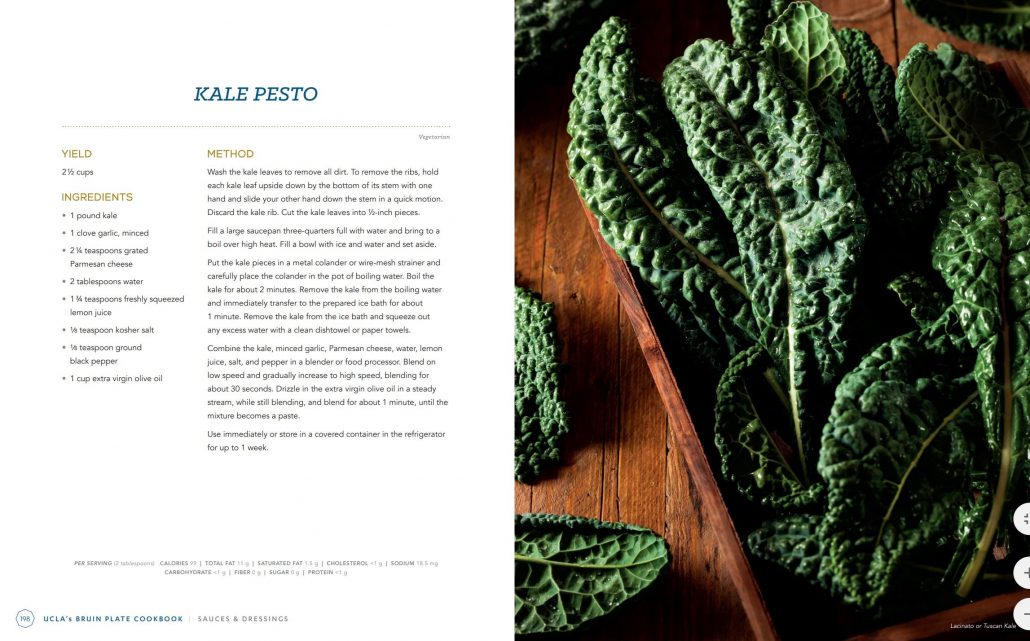
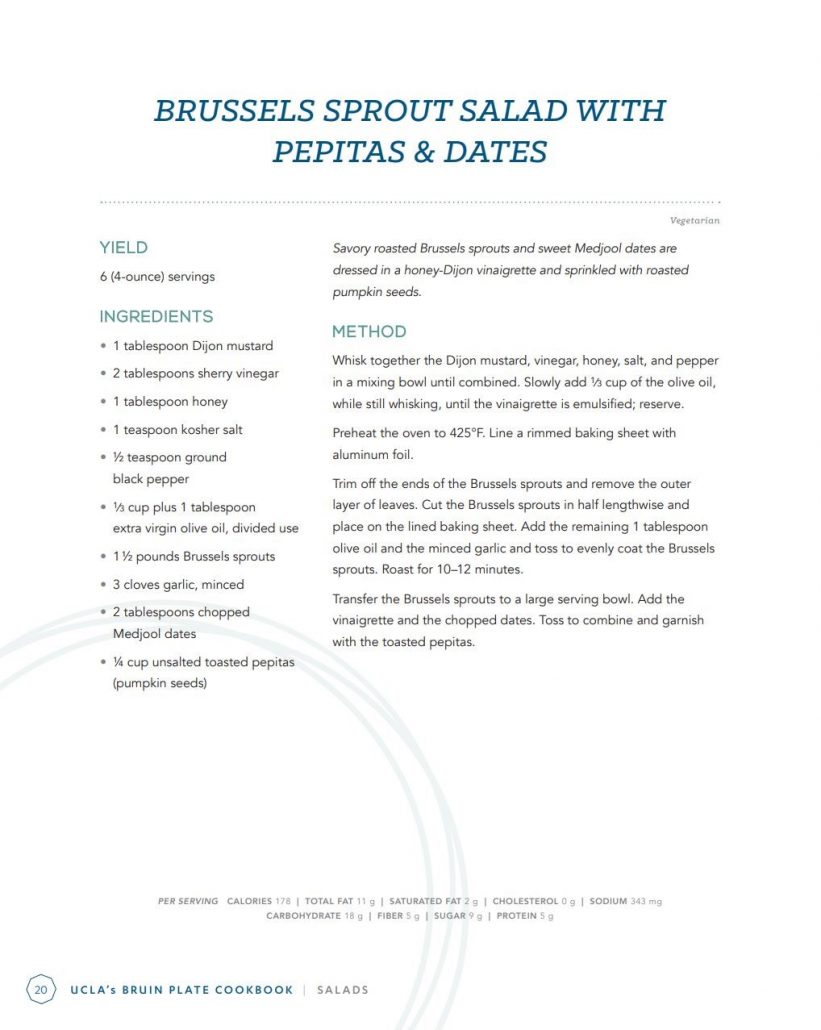
The cookbook is now sold at the UCLA Store for $34.95, with an additional 30% discount for UCLA students, staff and faculty when UCLA ID is shown. With this discount, the cost reduces to less than $0.20 per recipe.
All proceeds from the book sales support the elimination of food insecurity for UCLA students and for the Los Angeles community through the Semel HCI Center at UCLA and the UCLA Basic Needs Committee. Here’s to Bruin Plate dining, now accessible to anyone! For more information about how to support food insecure students at UCLA and/or to access resources please click here.
Those seeking cheaper ways to eat nutritiously off campus can find resources in other EatWell blog posts:
To register for Imperfect Produce deliveries: https://www.imperfectproduce.com/join
Patience Olsen is an undergraduate student at UCLA majoring in Civil Engineering. In addition to blogging for the EatWell Pod, she volunteers at the Mildred E. Mathias Botanical Garden on campus, and is a member of the ASCE Environmental Design project.